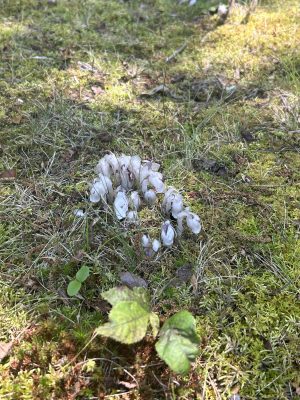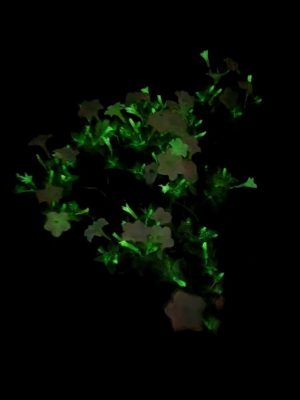By Emily Leahy, UConn Plant Diagnostic Lab
While meandering around my backyard this past weekend, I spotted a striking plant which I had never seen before. At first instinct, I assumed it was a particularly unique fungal species and snapped a couple pictures. My curiosity having been piqued, I did some research and learned that it was in fact not a fungus, but a parasitic plant reliant on fungus – Monotropa uniflora. Its name is self-descriptive; Monotropa, illustrating the single turn of its shepherd hook shape, and uniflora, depicting the lone flower produced on each stem. It is also known as “Ghost Plant” or “Indian Pipe.”

Perhaps the most unusual feature of Monotropa uniflora is its color, or lack thereof. While mostly white-colored overall, hues of pink can be visible along with black flecks spread along the plant. The translucent nature of the plant is derived from the absence of chlorophyll, a green pigment and key component allowing autotropic plants to perform photosynthesis.
Autotrophs are organisms that convert abiotic (non-living) sources of energy, like sunlight, into organic compounds they can use for food production. Most plants have this ability, using the chemical reactions in photosynthesis to produce carbohydrates for their own nourishment. However, Monotropa uniflora, a heterotrophic plant, cannot carry out such processes. They seek the organic compounds needed to sustain themselves from external sources. Autotrophs are often referred to as “producers” and heterotrophs “consumers” to illustrate this distinction. Since Monotropa uniflora is not directly dependent on sunlight for survival, it is often found in shaded areas and forests.
This all begs the question – where does Monotropa uniflora get its nourishment from? The answer comes in the form of its parasitization of mycorrhizal fungi and surrounding trees. The term “mycorrhizal” is used to describe fungi that form a symbiotic relationship with the roots of its host plant. The interaction is mutually beneficial – mycorrhizal fungi receive sugars and carbon from its host, which in turn is aided by the fungus in its absorption of water and nutrients. The root system of the host plant is used as a transportation highway in these interactions.
Monotropa uniflora inserts itself as a third player in the relationship, disrupting its balance. In a clever sleight of hand, the parasite tricks the mycorrhizal fungi into thinking it is forming another symbiotic relationship as its root system interacts with the fungal mycelium. However, the benefits of this interaction are strictly one-sided as Monotropa siphons the carbohydrates, initially derived from the mycorrhizae’s host trees, for its own consumption. This is not severely detrimental to the fungi or host plants, but it certainly detracts from the vigor of their symbiotic relationship and the amount of available resources transferred between the two entities.
Monotropa uniflora has a wide range of distribution throughout the U.S., so it is possible to see these fascinating plants in action in a variety of locations. Its flowering season ranges from early summer to early fall and it thrives even after seeds are released.
A microcosm of ecological phenomena, Monotropa uniflora is quite the unique find. It is enthralling not only to observe, but also to know the complex interactions that occur just below ground. I say we can overlook its parasitic tendencies and appreciate its role in the delicate balance of our natural world – after all, everyone loves a good villain, right?
Need help identifying something interesting in your garden? We’re here to help! The UConn Home & Garden Education Center supports UConn Extension’s mission by providing answers you can trust with research-based information and resources. For gardening questions, contact us toll-free at (877) 486-6271, visit our website at homegarden.cahnr.uconn.edu, or reach out to your local UConn Extension center at cahnr.uconn.edu/extension/locations.
This article was published in the Hartford Courant July 19, 2025

